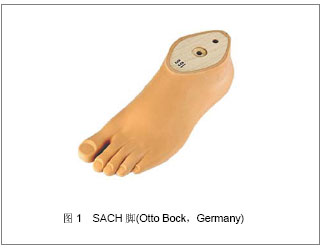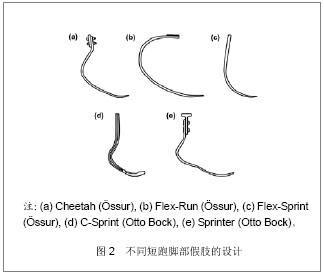| [1] 龚思远,杨鹏,宋亮,等. 基于迭代学习控制智能下肢假肢研制:实现了对健肢步速的跟随[J]. 中国组织工程研究与临床康复, 2010, 14(13):2295-2298.
[2] 田万成,朱大成,潘风雨,等. 炸伤及创伤下肢残肢的假肢装配及功能康复训练[J]. 实用医药杂志,2008,25(4):396-397.
[3] 张晓玉. 现代假肢中新结构、新材料和新工艺[J].中国临床康复,2002,6(20):2989-2991.
[4] 王爱英,王维波. 小腿近端截肢部位与假肢接受腔选择问题的探讨[J]. 中国矫形外科杂志,2001,8(11):1133-1134.
[5] Gerzeli S, Torbica A, Fattore G. Cost utility analysis of knee prosthesis with complete microprocessor control (C-leg) compared with mechanical technology in trans-femoral amputees. Eur J Health Econ. 2009;10(1):47-55.
[6] 蒋翌军,袁正华.储能式复合材料运动假肢(腿和足弓)成型工艺研究[J].纤维复合材料,1997,6(2):13-16.
[7] Zhang M, Roberts C. Comparison of computational analysis with clinical measurement of stresses on below-knee residual limb in a prosthetic socket. Med Eng Phys. 2000;22(9): 607-612.
[8] 仇玉书.假肢-复合材料开发应用的新领域[J].特种纤维和复合材料,1995,12:16-18.
[9] 仇玉书.碳纤维及其织物的假肢制品[J].高科技纤维与应用,1996, 11,12:37-39.
[10] 张晓玉.现代假肢中新结构、新材料和新工艺[J].中国临床康复, 2002,6(20):2989-2991.
[11] 赵辉三.假肢与矫形器学[M].北京:华夏出版社,2010:60-65.
[12] Thompson H. Performance enhancement: Superhuman athletes. Nature. 2012;487(7407):287-289.
[13] Postema K, Hermens HJ, de Vries J, et al. Energy storage and release of prosthetic feet. Part 1: Biomechanical analysis related to user benefits. Prosthet Orthot Int. 1997;21(1): 17-27.
[14] Rouse EJ, Hargrove LJ, Peshkin MA, et al. Design and validation of a platform robot for determination of ankle impedance during ambulation. Conf Proc IEEE Eng Med Biol Soc. 2011;2011:8179-8182.
[15] Brown MB, Allison AR, Millard-Stafford ML. Running prosthesis facilitates greater speed, peak aerobic capacity, and improved exercise economy in amputee runners. Medicine & Science in Sport & Exercise. 2007;39(Suppl.): S244–245.
[16] Silver-Thorn B, Current T, Kuhse B. Preliminary investigation of residual limb plantarflexion and dorsiflexion muscle activity during treadmill walking for trans-tibial amputees. Prosthet Orthot Int. 2012;36(4):435-442. PMID:22581661
[17] Fey NP, Klute GK, Neptune RR. Optimization of prosthetic foot stiffness to reduce metabolic cost and intact knee loading during below-knee amputee walking: a theoretical study. J Biomech Eng. 2012;134(11):111005.
[18] Takahashi KZ, Stanhope SJ. Mechanical energy profiles of the combined ankle-foot system in normal gait: Insights for prosthetic designs. Gait Posture. 2013 Apr 26.
[19] Nolan L. Carbon fibre prostheses and running in amputees: a review. Foot Ankle Surg. 2008;14(3):125-129.
[20] Herr H. Exoskeletons and orthoses: classification, design challenges and future directions. J Neuroeng Rehabil. 2009 Jun 18;6:21.
[21] Pailler D, Sautreuil P, Piera JB, et al. Evolution in prostheses for sprinters with lower-limb amputation. Ann Readapt Med Phys. 2004g;47(6):374-381.
[22] Wilson JR, Asfour S, Abdelrahman KZ, et al. A new methodology to measure the running biomechanics of amputees. Prosthet Orthot Int. 2009;33(3):218-229.
[23] Buckley JG. Biomechanical adaptations of transtibial amputee sprinting in athletes using dedicated prostheses. Clin Biomech (Bristol, Avon). 2000;15(5):352-358.
[24] Czerniecki JM, Gitter A, Munro C. Joint moment and muscle power output characteristics of below knee amputees during running: the influence of energy storing prosthetic feet. J Biomech. 1991;24(1):63-75.
[25] Hirons R. Preparing our Paralympians: research and development at Ossur, UK. Interview by Sarah A. Curran. Prosthet Orthot Int. 2012 Sep;36(3):366-369.
[26] Ciobanu O. The use of CAD/CAM and rapid fabrication technologies in prosthesis and orthotics manufacturing. Rev Med Chir Soc Med Nat Iasi. 2012;116(2):642-648.
[27] Hafner BJ, Sanders JE, Czerniecki JM, et al. Transtibial energy-storage-and-return prosthetic devices: a review of energy concepts and a proposed nomenclature. J Rehabil Res Dev. 2002;39(1):1-11.
[28] Zmitrewicz RJ, Neptune RR, Walden JG, et al. The effect of foot and ankle prosthetic components on braking and propulsive impulses during transtibial amputee gait. Arch Phys Med Rehabil. 2006;87(10):1334-1339.
[29] Barr JB, Wutzke CJ, Threlkeld AJ. Longitudinal gait analysis of a person with a transfemoral amputation using three different prosthetic knee/foot pairs. Physiother Theory Pract. 2012;28(5):407-411.
[30] Sanderson DJ, Martin PE. Joint kinetics in unilateral below-knee amputee patients during running. Arch Phys Med Rehabil. 1996;77(12):1279-1285.
[31] Beyaert C, Grumillier C, Martinet N, et al. Compensatory mechanism involving the knee joint of the intact limb during gait in unilateral below-knee amputees. Gait Posture. 2008; 28(2):278-284.
[32] Brouwer BJ, Allard P, Labelle H. Running patterns of juveniles wearing SACH and single-axis foot components. Arch Phys Med Rehabil. 1989b;70(2):128-134.
[33] Nolan L, Patritti BL, Simpson KJ. A biomechanical analysis of the long-jump technique of elite female amputee athletes. Med Sci Sports Exerc. 2006;38(10):1829-1835.
[34] Nolan L, Lees A. The influence of lower limb amputation level on the approach in the amputee long jump. J Sports Sci. 2007; 25(4):393-401..
[35] Versluys R, Beyl P, Van Damme M, et al. Prosthetic feet: state-of-the-art review and the importance of mimicking human ankle-foot biomechanics. Disabil Rehabil Assist Technol. 2009;4(2):65-75.
[36] 崔海坡,周海风,程恩清.碳纤维复合材料特性及在假肢领域的应用[J].中国组织工程研究与临床康复,2009,13(25):4913-4915.
[37] 刘劲松,刘志泉. 现代高分子材料在假肢矫形技术领域中的应用[J].中国康复理论与实践,2004,10(10):634-635.
[38] Yeung LF, Leung AK, Zhang M, et al. Long-distance walking effects on trans-tibial amputees compensatory gait patterns and implications on prosthetic designs and training. Gait Posture. 2012;35(2):328-333.
[39] 贾晓红,李小兵,王人成,等. 一体化小腿假肢对线角度优化设计[J]. 清华大学学报-自然科学版,2007,47(5):647-650.
[40] 孔梅, 李炜,李海丽,等. 四种常用假肢材料与人体皮肤摩擦学特性的研究[J]. 生物医学工程学杂志,2008,25(5):1107-1111.
[41] 樊瑜波,蒲放,张明,等. 个体化下肢小腿假肢接受腔设计的生物力学评价技术研究[J]. 中国生物医学工程学报, 2004,23(6): 544-548.
[42] 方丽丹,贾晓红,罗勇,等. 小腿假肢接受腔-残肢生物机械系统三维重构[J]. 中国康复医学杂志,2007,22(1):55-57.
[43] 张绍岚,李古强,邵长庆,等.小腿假肢接受腔计算机三维模型的构建[J]. 中国组织工程研究与临床康复, 2010,14(48): 8954- 8957.
[44] McNealy LL, Gard SA. Effect of prosthetic ankle units on the gait of persons with bilateral trans-femoral amputations. Prosthet Orthot Int. 2008;32(1):111-126.
[45] 刘展,樊瑜波,张明,等. 壁面厚度对一体化小腿假肢应力分布的影响[J]. 生物医学工程学杂志,2004,21(4):562-565.
[46] 彭爱民,韩义连,韩庆海,等. 仿踝关节生理运动跟腱弹性牵伸器在小腿Ilizarov延长中的应用[J]. 中国矫形外科杂志,2012,20 (21): 1939-1943.
[47] Pailler D, Sautreuil P, Piera JB, et al. Evolution in prostheses for sprinters with lower-limb amputation. Ann Readapt Med Phys. 2004;47(6):374-381. |


